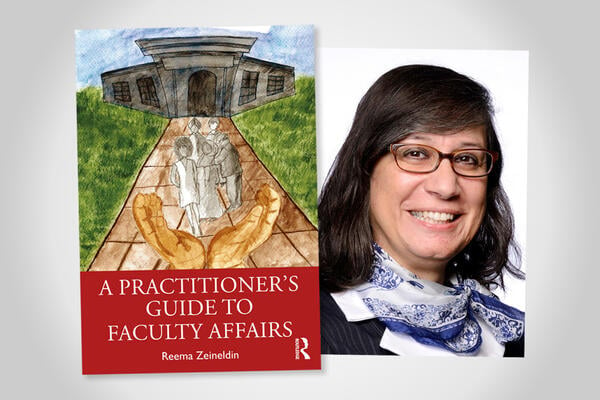
How to Make Faculty Affairs Work at Any Institution
Most colleges and universities have an office for student affairs; there’s even a national professional organization—NASPA—dedicated to student affairs administrators. Faculty affairs hasn’t received the same attention, though, and essential work is slipping through the cracks, says Reema Zeineldin, an independent consultant and longtime faculty affairs professional who has worked at Framingham State University, Mercy University and Mount Ida College.
Zeineldin has spent years identifying these gaps and is working to make faculty affairs work better understood and bring it into the higher education mainstream. In her new book, A Practitioner’s Guide to Faculty Affairs (Routledge 2025), Zeineldin offers best practices, case studies and worksheets for professionals looking to establish or strengthen faculty affairs offices at their own institution.
In a Zoom interview with Inside Higher Ed, Zeineldin dived into what exactly comprises faculty affairs work, why it is important and how institutions should approach establishing their own faculty affairs units.
The interview has been edited for length and clarity.
Q: I hear the term “faculty affairs” all the time, but what exactly does it mean? What does it encompass?
A: It’s basically all the matters, issues, policies and practices that have to do with faculty. In [the first chapter], I make a list of what falls into the scope of faculty affairs: staffing planning, recruitment and hiring, onboarding, orientation, faculty development, mentorship. Then there is faculty workloads and faculty personnel actions, which also includes things in relation to promotion, tenure, faculty review, faculty recognition, separations, retirement and beyond retirement.
And then there are certain specialized things in relation to interfacing with other offices within the campus that also handle things in relation to faculty affairs. It could be the Title IX officer, it could be general counsel, the diversity officer, Student Affairs and sometimes the advancement office or student government.
Q: You’ve made your career in faculty affairs. What motivated you to pursue that line of work?
A: I started doing faculty affairs before going into a position with that title, because I was a dean in Mount Ida College. It was a small college, and being a small college meant that it didn’t have its own dedicated faculty affairs unit, so the deans really took on all of these responsibilities.
Some institutions do not have a faculty affairs unit at all, and the functions of faculty affairs may fall on the provost, the deans, department chairs, program coordinators, human resources or maybe even chief diversity officers. And then there are some larger research institutions that have more than one faculty affairs unit, like one for the medical school and one for the arts and sciences. In reality, the medical schools have been a pioneer in all of this, because they did start the work early on before any other organization.
The more I practiced [faculty affairs], the more it became clear to me: Oh, I need to put something together. So, that was the mission. I realized that there is a need to talk more about this.
Q: For institutions that don’t have an institutionwide faculty affairs unit, what’s most likely to get missed?
A: It varies from one institution to another … because, first of all, institutions don’t have one category of faculty. You have the full-time faculty and part-time faculty. Even within the full-time faculty, you may have those on a tenure line and maybe other faculty who are on contracts. Some of the [contracted faculty] are temporary and some are core faculty, voting faculty in the institution. So one would have to examine each case separately and go through the various functions. I’ve created a worksheet for this—how to think about this and to analyze what is falling through the cracks.
A recent thing that was discussed in the Committee of Faculty Affairs group was faculty recognition. It’s easy to recognize scholarship or give a teaching award, but there are other categories of recognition that are sometimes forgotten. So what do you do about this? How do you improve faculty recognition within the institution? One of the functions faculty affairs supports is faculty success, which is very important. Faculty affairs serves both the faculty and the institution, because it makes sure that policies and practices are followed.
Q: If you were designing your ideal faculty affairs unit, what would it look like?
A: Again, there isn’t one size that fits all, because it depends on the institution, their size and their capabilities and their budgets. So in my opinion, each institution has to evaluate it on their own. Because of this variation, I invited various colleagues to contribute case studies to the book where they’re sharing actual things they’ve done within their institution. And for each case study, I asked them to begin by describing the faculty affairs unit. This could be informative to the reader, like, “Oh, I’m really interested in research or an R-1 institution, let’s see a case study for that. What does their faculty affairs unit look like?” Or “I’m interested in a teaching-focused institution that’s large, or maybe a small institution that doesn’t have a faculty affairs unit at all, but somebody does the work.”
Q: In the book you emphasize the importance of thinking about contingent faculty—which you call VITAL faculty—differently from noncontingent faculty. Why is that?
A: A lot of times the VITAL faculty (visiting, instructors, temporary, adjunct, lecturers), are just told by the institution, “Here is a course; we want you to teach it.” Sometimes they feel they are on their own. And then, because they are not full-time at the institution, they need their own specialized type of support. So each institution needs to think about how to make those faculty feel that they belong.
Because of this, each chapter ends … with a paragraph or two about VITAL faculty and what from the chapter is applicable to them.
Q: Institutions are increasingly fielding criticism of administrative bloat, and so creating a new administrative unit or hiring more staff could be a hard sell. Is there a way to create a faculty affairs unit that doesn’t strain the budget?
A: Ideally, institutions should dedicate financial resources. But the reality is, a lot of institutions are strapped for their budgets, and that means that they may not be capable of doing that … They would need to evaluate the risks and rewards, and part of that is budget impact—is this something they can afford to do? Can they consolidate? Can they look at certain positions that already exist—and the reality is there are people doing faculty affairs all over the institution—and can we make them more specialized? Can we take out the other functions and add them to somebody else?
Q: Faculty support seems to be extremely necessary right now. With all of the public and political criticism of academia and higher education, are you seeing faculty morale take a hit?
A: Yeah, definitely. Faculty morale has been worse since COVID. And now, with all that’s happening in the current administration—the encroachments into the universities and the faculty’s work or teaching; the banning of diversity, equity and inclusion; and the accusations of antisemitism for anything anybody says [to criticize] the government of Israel—all of this silencing, and sometimes it’s leading people to be fired.
Faculty already struggled with burnout. I mean, maybe the positive side effect of COVID is that it brought attention to all these matters—faculty well-being, mental health, burnout—not that much has been done about it. So what’s happening now is, first of all, shocking to people, and I think it’s taking them a while to get what’s happening. At the same time, it is impacting their morale, and this time especially they are not getting support from their institutions. At least during COVID, institutions were saying, “Oh, we get it.” But now, because institutions are just very fearful, they’re just not getting institutional support.
Source link


